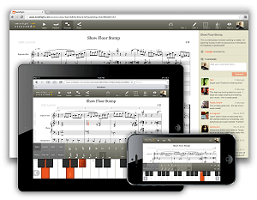Today Noteflight released to the public their new updated version of their popular online music notation program. The big news? Those on tablets such as the iPad can finally use Noteflight and all of its capabilities without resorting to end-around methods like using special browser apps. So after all of the hype about Noteflight 3.0 on the iPad was it worth the wait?
First of all let’s agree, the task of making a solid, usable cross platform music notation editor is insanely complex. Creating a music notation program using a programming language designed to create web pages is something akin to voodoo magic. Noteflight had their work cut out for them the day they decided to commit to the project and their work has, for the most part, began to bear fruit. When first venturing onto the Noteflight web site you will not immediately be presented with the new version of the program. It currently is defaulting to the standard Flash based app, so if you want to try out the new Noteflight you have to click the link at the top of the page or else you can just browse directly to www.noteflight.com/experience/r3.
Playback and Viewing of Noteflight Scores
The playback of existing scores in my testing was quite good. The first time I loaded into Noteflight on my iPad 2 I opened up a couple of popular scores written by other composers on the site. The music looked and sounded fine, although I was much happier with the sound quality once I logged into my Crescendo account. The only big issue I discovered with playback of existing scores is that it seems very dependent on the speed of the processor inside your device. On my iPad 2 large, complex scores loaded slowly, occasionally stuttered during playback, and showed screen tearing when the processor could not render the graphics fast enough. However, on my iPhone 5 and on the PC browser version I had no such problems and the experience was much improved.
Writing Music In Noteflight on the iPad
Creating and editing scores revealed a different set of challenges. The company says they are still working out a bunch of bugs in the new HTML5 version of Noteflight, so if you play with it for a bit you are bound to run into one or two. For me most of the problems were simply figuring out how to enter notes into the score. I kept trying to click a quarter note then tap a measure to enter it. On the iPad it doesn’t work that way. You can’t drag your finger around to position the note the way you can with a mouse on a PC because on the iPad this makes the whole screen move. Instead, on the iPad you select the measure you want to enter notes into, select the length of note desired, and then touch the appropriate key on the on screen piano keyboard. Now that I have it figured out it makes total sense, but getting there was frustrating to say the least.
New users should also be aware that while the new Noteflight should run on pretty much any HTML5 capable device, it will only play back the audio on browsers that support the HTML5 audio. As such if you are using Internet Explorer 10 or Firefox 4 you can create and edit music but you can’t play back the audio.
In the end, you really have to try the new Noteflight music notation program out for yourself. On the iPad I feel it is a decent product that is long overdue, but I almost wish they had left it in the cooker for a few more months to work out a few more problems before releasing it to the masses. The long term potential for Noteflight 3.0 is huge, as long as the company continues to give the product the attention and support that it deserves.

